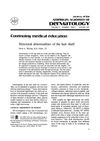TLDR Hair can be damaged by daily routines, but protein-based products can protect and improve it.
The document "Hair: Its structure and response to cosmetic preparations" from 1996 discussed the structural properties of hair and how it responded to various cosmetic treatments. It reviewed the composition and keratinization of hair, highlighting structural abnormalities such as trichorrhexis nodosa and trichoptilosis. The paper also examined the effects of shampooing and other cosmetic processes on hair integrity, including issues like matting and bubble hair. The study provided insights into the physical and chemical behavior of hair, contributing to a better understanding of hair care and treatment.
 126 citations
,
January 1987 in “Journal of The American Academy of Dermatology”
126 citations
,
January 1987 in “Journal of The American Academy of Dermatology” The document concludes that understanding hair structure is key to diagnosing hair abnormalities and recommends gentle hair care for management.
28 citations
,
July 1980 in “British Journal of Dermatology” The hair disorder was caused by abnormal protein formation, making hair easily damaged.
16 citations
,
October 2021 in “Trends in biotechnology” Future hair products will use ecofriendly proteins and peptides to improve hair health and appearance.

Nanocarriers with plant extracts show promise for safe and effective hair growth treatment.
298 citations
,
June 2019 in “Marine Drugs” Chitosan is a sustainable, versatile ingredient in cosmetics, enhancing skin hydration and anti-aging while promoting eco-friendly practices.
20 citations
,
January 2022 in “REVIEWS ON ADVANCED MATERIALS SCIENCE” Nanoparticles can make cosmetics more effective but have challenges like cost and safety.
 30 citations
,
February 2022 in “Pharmaceutics”
30 citations
,
February 2022 in “Pharmaceutics” 3D bioprinting improves wound healing by precisely creating scaffolds with living cells and biomaterials, but faces challenges like resolution and speed.


